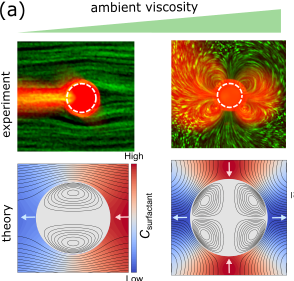How do self-propelling (artificial) microswimmers adapt to changes in their environment?
Adaptation of self-propelling (artificial) microswimmers to changes in their surroundings
- Adaptation to external flow in a microconfinement: In absence of flow, self-propelling artificial microswimmers (active droplets) swim by following the contours of the adjacent boundary (as you have seen in the video in the homepage). However, interestingly, in presence of an external flow in a microconfinement, these same active droplets swim upstream in a stable, oscillatory trajectory. Such adaptation to ambient flow, by exhibiting oscillatory upstream
rheotaxis, is reminiscent of bioswimmers like E.
coli and T. brucei. We have investigated experimentally and theoretically this oscillatory rheotaxis of artificial microswimmers in a microchannel. (Research done with Dr. Corinna C. Maass’ group at MPI-DS Goettingen.)
Refs. R. Dey, C. M. Buness, B. V. Hokmabad, C. Jin, C. C. Maass, “Oscillatory rheotaxis of artificial swimmers in microchannels”, Nature Communications 13 (1), 1-10, 2022 (https://rdcu.be/cOmNu). Also featured as Nature Communications Editors’ Highlight.

- Adaptation to changes in ambient viscosity: Self-propelling artificial microswimmers (active droplets) surprisingly adapt to increasing viscosity of the surrounding medium by exhibiting increasingly chaotic motion even in the non-inertial regime (Stokes regime). Such non-intuitive behaviour stems from the underlying coupling between the hydrodynamic and solute (surfactant) transport aspects of the active droplet system. With increasing viscosity, higher hydrodynamic modes become excitable. The droplet then recurrently switches between the two dominant modes due to interactions with the self-generated chemical (filled micelle) gradients associated with the higher of the two modes. This mode switching results in the emergence of multimodal motility, which has never been explored before. Such bimodal motility promotes self-avoiding walks mimicking examples of efficient spatial exploration strategies observed in nature. (Research done with Dr. Corinna C. Maass’ group at MPI-DS Goettingen.)
Refs. B. V. Hokmabad, R. Dey, M. Jalaal, D. Mohanty, M. Almukambetova, K. A. Baldwin, D. Lohse, C. C. Maass, “Emergence of bimodal motility in active droplets”, Physical Review X 11 (1), 011043, 2021.
Electrically controlled evolution of drop condensation patterns
- Have you ever looked at drop condensation patterns and wondered what if they were controllable? Well, we showed that the patterns formed by water drops condensing on a flat surface (breath figures) can be indeed controlled and modified by applying electric field using patterned electrodes underneath a hydrophobic dielectric film. The condensing drops migrate to and align at their size-dependent electrostatic energy minima locations in the underlying energy landscape. Such migration of the condensate drops results in enhanced coalescence and periodic spatial alignment. In general, we demonstrated and explained for the first time that breath figure characteristics can be controlled by imposing a lateral energy landscape using suitably tailored electrode designs. Furthermore, we also demonstrated that the application of ac electric field results in enhanced shedding of the condensate drops due to reduced surface hysteresis, which has a direct consequence for technological applications. (Research done with Prof. Dr. Frieder Mugele’s group at University of Twente.)

Refs. 1. D. Baratian*, R. Dey*, H. Hoek, D. van den Ende, F. Mugele, “Breath Figures under Electrowetting: Electrically Controlled Evolution of Drop Condensation Patterns”, Physical Review Letters 120 (21), 214502, 2018 (*joint first authors).
2. R. Dey, J. Gilbers, D. Baratian, H. Hoek, D. van den Ende, F. Mugele, “Controlling shedding characteristics of condensate drops using electrowetting”, Applied Physics Letters 113 (24), 243703, 2018 (Selected as `Editor’s pick’)
3. H. Hoek, R. Dey, F. Mugele, “Electrowetting-controlled dropwise condensation with patterned electrodes: Physical principles, modeling, and application perspectives for fog harvesting and enhanced heat transfer”, Advanced Materials Interfaces 8 (2), 2001317, 2021.
Soft electrowetting

- In this series of works, we explained for the first time the inter-connection between electrically controlled wetting/spreading of sessile drops (electrowetting) on soft dielectric films and the underlying deformation of the soft film. The macroscopic static contact angles during electrowetting, even on soft dielectric films, can be described using global energy conservation principles, and are independent of the substrate elasticity. However, the electrospreading dynamics is completely dictated by the substrate’s viscoelasticity via its deformation. We further demonstrated the use of electrowetting as a tool to probe the microscopic deformations of elastic lamellae constituting a superhydrophobic substrate under different wetting conditions. (This topic was part of Ranabir’s doctoral thesis; subsequent research was done with Prof. Dr. Frieder Mugele’s group and Prof. Jacco Snoeijer’s at University of Twente.)
- A. A. Dev, R. Dey, F. Mugele, “Behaviour of flexible superhydrophobic striped surfaces during (electro-) wetting of a sessile drop”, Soft Matter 15 (48), 9840, 2019. (Cover Article).
- R. Dey, M van Gorcum, F. Mugele, J. H. Snoeijer “Soft electrowetting”, Soft Matter 15, 6469, 2019.
- R. Dey, S. DasGupta, S. Chakraborty, “Electrically modulated wetting of drops on soft dielectric elastomer films”, Microfluidics and Nanofluidics 21 (3), 48, 2017.
- R. Dey, A. Daga, S. DasGupta, S. Chakraborty, “Electrically modulated dynamic spreading of drops on soft surfaces”, Applied Physics Letters 107 (3), 034101, 2015.